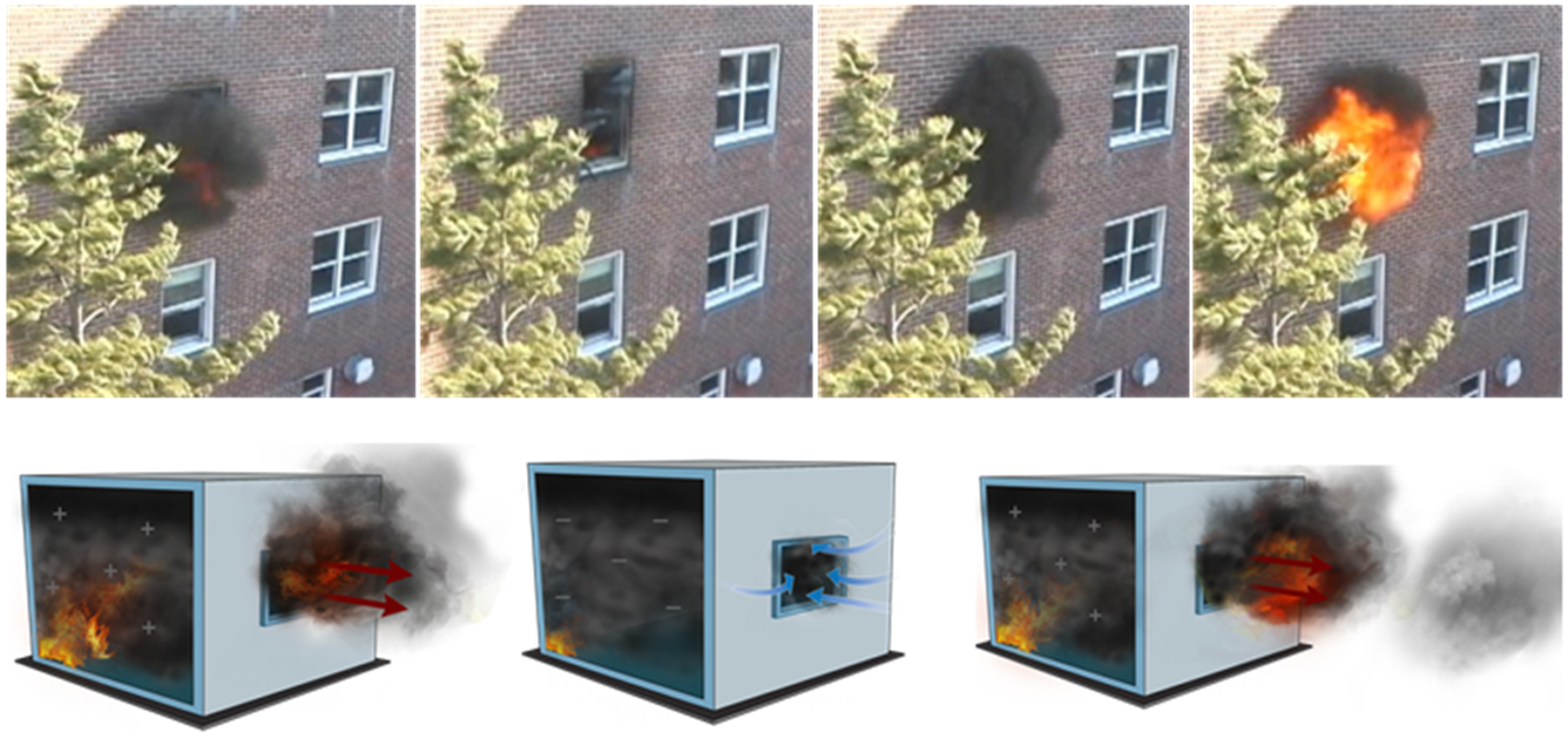Dynamic Flow
A unidirectional or bidirectional flow of smoke/air that presents irregular stratification and shape, or alternates in direction (pulsations) is identified as dynamic flow. Under normal fire conditions, the gravity current will dominate the layering of hot buoyant smoke and cooler air within a compartment. This gravity current leads to a clearly delineated smoke/flame layer exiting across the upper section of an opening or moving within a volume, as well as cooler air layered below it.
Winds blowing into a closed fire compartment can lead to a high-pressure zone in the compartment. Under normal wind conditions, a room with only one opening will display a bidirectional smoke/air track. This will be either fuel-controlled (smooth flow) or ventilation-controlled (turbulent flow). In a wind-impacted scenario resulting from high winds, the opening can aggressively alternate from a total inlet to a total exhaust outlet with a range of unique vent profiles. Alternatively, a steady-state unidirectional flow may also present a unique vent profile.
|
In a wind-impacted flow path, fire control is only safely achieved via the introduction of water from a position protected from or remote to the flow, by controlling openings and/or using wind-control devices. |
Pulsations and Whistling Noises
Smoke observed pulsing out of openings is a result of variations in pressure due to limited oxygen supply, and indicates a ventilation-controlled fire. As the oxygen level decreases, so does the intensity of the combustion process. This condition, in turn, decreases the temperature and consequently the volume of hot smoke. This condition causes air to be drawn in, increasing the fire intensity and internal pressure until the air is consumed and the cycle starts again. Audible indicators such as whistling noises may also help one to recognize the presence of pulsations. The whistling noises result from smoke/air being pushed in and out of the compartment through small gaps or openings that result from pressure variations. It should be noted that it can be difficult to notice this audible indicator above the background noise.
In some cases, pulsations can develop into a situation where the sudden opening of the compartment could lead to backdraft. Extreme caution should be exercised before creating any opening in these conditions. It is important for firefighters to cool the smoke and surfaces while undertaking door control before tactical venting operations begin.
Warning Signs
In the case of fires impacted by wind and/or varying gas pressures due to the combustion cycle of the fire (pulsations), the layering characteristics of the flow-and therefore the vent profile(s)-will present in an irregular manner.
Examples of irregular vent profiles are shown in Figure 24, and can be described as:
- Eccentric;
- Projected;
- Inverted;
- Hollowed;
- Pulsations (such as puffing); and
- Star fire.






Figure 24 (above): Irregular vent profiles.
Atypical vent profiles may also be a combination of the above irregular vent profiles, the combinations and degree of presentation being limitless.
|
The critical point here is that the smoke/air track characteristics are abnormal and may be unidirectional, bidirectional or may alternate dynamically. REMEMBER: Evaluate the ventilation profile! |
|
'The men of the fire brigade were taught to prevent, as much as possible, the access of air to the burning materials. What the open door of the ash-pit is to the furnace of a steam-boiler the open street door is to the house on fire. In both cases the door gives vital air to the flames.' - Chief Fire Officer James Braidwood, 1866 |